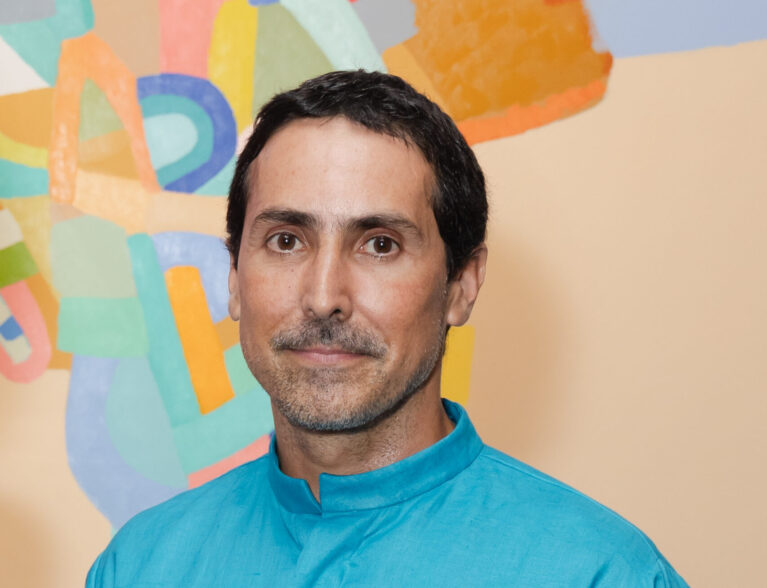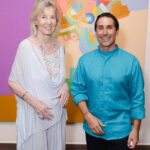
The Gallery at Windsor continues its tradition of exhibiting works by leading contemporary artists, this year presenting a solo exhibition of paintings and monotypes by Costa Rican artist Federico Herrero entitled ‘A Piece of Waterfall in the Sound of Crickets.’ The show’s title is derived from a poem by acclaimed Costa Rican poet Alfonso Chase.
The exhibition, which runs until April 26, includes a selection of recent pieces by the artist, who for the past 20 years has produced a vast quantity of works on canvas as well as large-scale outdoor murals, street art and site-specific commissioned artworks.
“His signature style of playful geometric abstractions and architectural interventions reflect day-to-day life in the tropics, and frequent trips between San José and New York,” wrote Elena Ketelsen Gonzalez, curator of this exhibition and assistant curator at MoMA PS1, in the exhibit’s accompanying catalog.
Herrero’s works caught the attention of Hilary Weston, Windsor co-founder and the gallery’s creative director, who wrote in the catalog’s forward, “His compositions resonate strongly with the tropical setting of Windsor and the dynamic lifestyle of our community.”
The walls of the gallery are awash with the joyfully exuberant patches of geometrically patterned color that populate his pieces. Herrero says his paintings are inspired by the lush beauty of his county, often juxtaposed with the ordered structures of northern cities.
Herrero says he incorporates everyday observances into his works, expressively abutting vibrantly hued shapes that represent the lushness of his country, with the urban culture encroaching upon it.
“Most of the paintings are, in a way, a reflection of my experiences between the urban structures of the cities and the landscapes of nature; the point where they touch each other,” he explains.
When walking along streets, Herrero says he often takes photographs of things that interest him, relating to the photos as found paintings.
“They originate in the notion of the found object, and they start to become very interesting.
And I think that creates a type of connection to how you navigate cities,” he explains.
As with many contemporary artworks, some pieces are more easily interpreted than others.
Case in point, two large-scale paintings hung in the gallery’s east hall.
In “Lost at Sea” (2023), what is recognizable as a boat is set against the soothing blues of ocean and sky and lavender hued mountains. It, he says, is based on memories of his travels by ferry from one place to another.
“During this transit there is always a pause on my life. It’s also surrounded by the shapes of distant mountains that appear through the gulf of Nicoya, and sometimes there are sightings of maritime wildlife such as whales, dolphins and turtles. These appear in the paintings as the inhabitants of these places.”
The less recognizable “Cangri” (2019) is a multicolored mix of shapes set against a vibrant green background. It, he says, is more a transformation between landscape and being.
“The picture is framed in such a way that allows a creature to be seen, with legs that resemble a crab or any small sea creature moving in a green space. But if you look closely you will find in these paintings that there is sometimes space between the forms, suggesting there something is more below the surface.”
Color, says Herrero, is an expression of space: the absence of it, the abundance of it, and the relationship between them.
“When painting on a canvas, you know there is no transgression; it acquires a rhythm of production that is related to yourself. One deals with a personal universe, the other deals with a social vocation,” he explains.
“Most of the time, I am interested in a certain type of transfer that can occur between mediums. Let’s say in the combination of color and forms, there is the potential to become language structures. And between spaces and languages there is space for open interpretations.”
He explains that these open structures behave, as humans do, in a conditioned way and tend to change according to the elements around them. “It’s a very moving system almost behaving as mobiles.”
Born in San José in 1978, Herrero says that he always knew he would become an artist.
“Early in my life I was already quite into making art and I started to understand better what it meant. Even when I was truly figuring out what I was going to do with my life, it was a very clear feeling in my life that I was going to do this,” says Herrero.
He admits, though, that his family was concerned about his being able to make a living that way.
“For me, I was OK with living a very simple life in the countryside. It was a situation that I felt OK with. Fortunately, for my family and for myself, I was able to establish early on and I was able to have an income to pay my rent. I was lucky,” he says.
“There are people in the art world who are very good artists and still have not been able to make it. So I always understood my parents’ concern.”
Herrero attended the Pratt Institute in New York City but soon returned home, taking with him a new perspective after experiencing life in the big city.
While he says Pratt was an important part of his education, even more instrumental was the relationship he had with Joaquín Rodríguez del Paso (1961 to 2016), a Costa Rican artist and art critic, who was one of the first artists to introduce contemporary art to that country.
“He was a very key figure to artists of my generation here. He was very generous teaching us but also introducing us to people. So he was very kind to introduce my work to his galleries at that time and that’s how my first show came about,” Herrero recalls.
“That was a very beautiful gesture from him and allowed me to start showing my work. That was in 2000. Very quickly after that show, a curator from Venice was researching in the area and he saw my work. So right the next year, 2001, the curator invited me to Venice and that’s when I started to connect internationally. So that was a very quick jump.”
Indeed, after he received the coveted Young Artist’s Prize at the 49th Venice Biennale, his works rapidly found worldwide recognition within galleries and museums.
Like his mentor, Herrero is now fostering the next generation of artists. He is the founder of two contemporary art spaces in San José, Despacio and Cero Uno, to encourage local and international artists to communicate with one another and develop new tendencies in the arts.
The Gallery at Windsor is open to the public by appointment. While there is no admission, a suggested $15 donation to the Windsor Charitable Foundation supports arts education.
For more information and public viewing times, visit WindsorFlorida.com.
Photos provided





